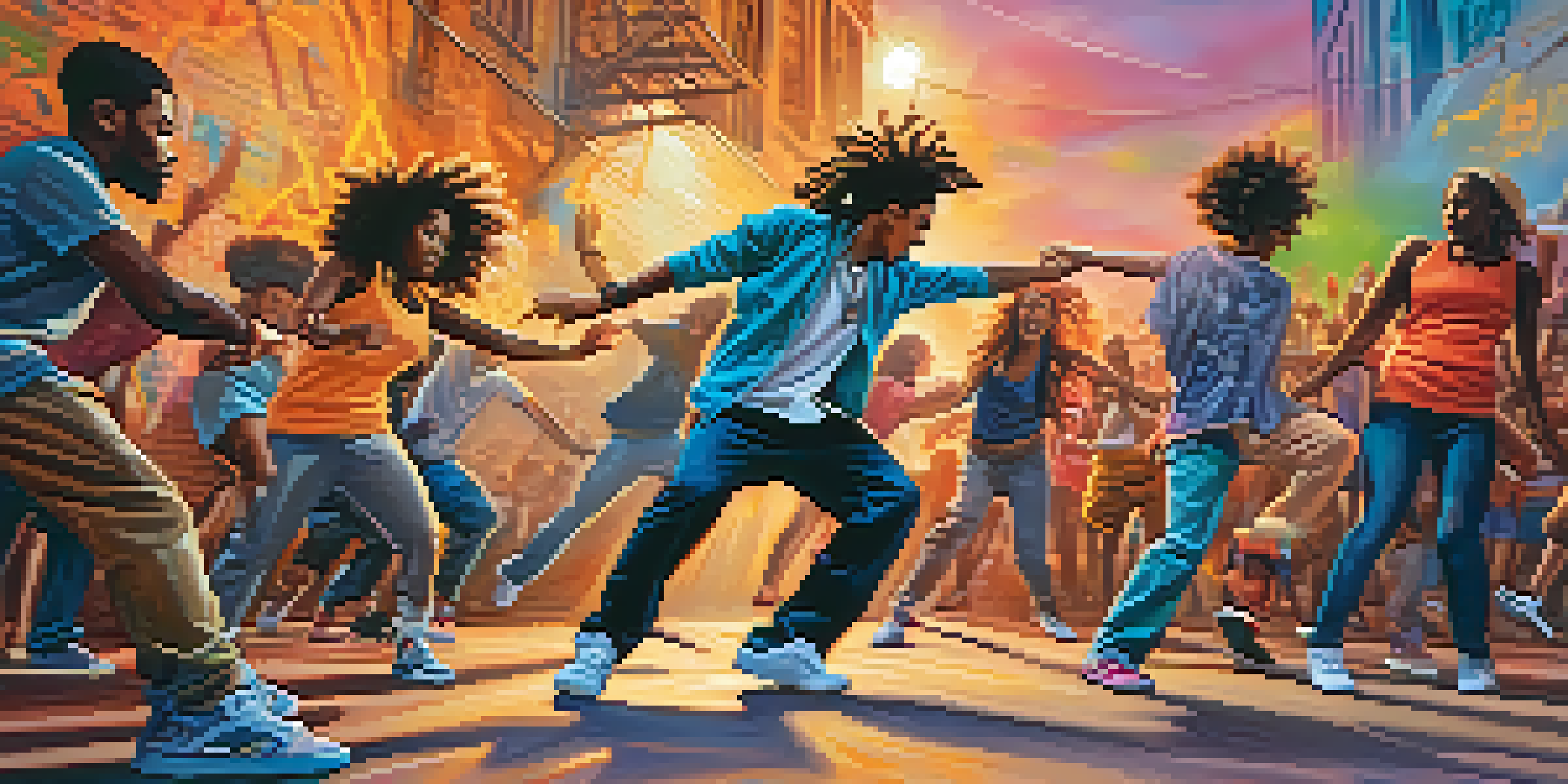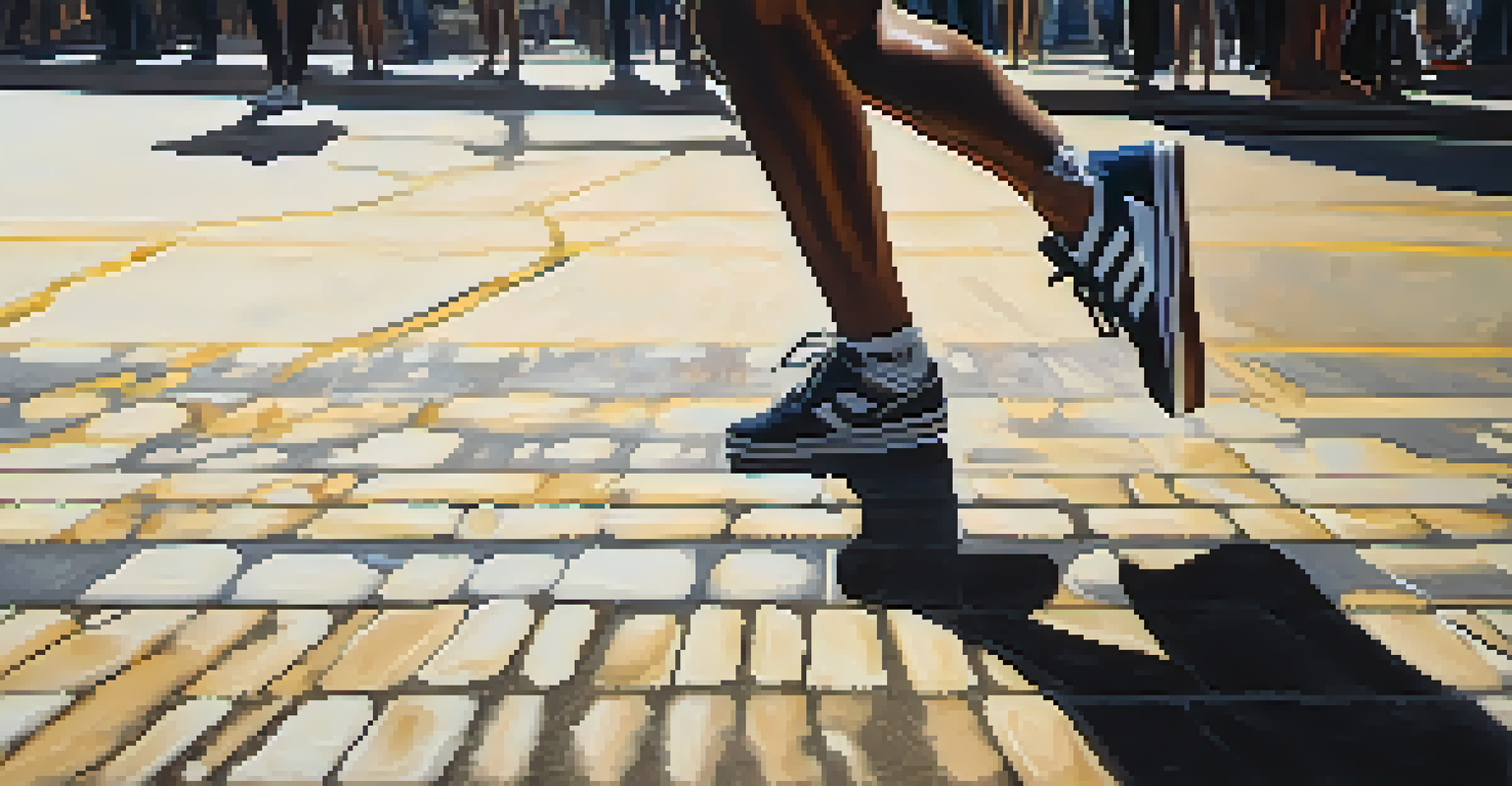Street Dance: The Pulse of Urban Activism and Expression

The Roots of Street Dance: A Cultural Melting Pot
Street dance has its origins in diverse urban communities, blending various cultural influences. From hip-hop to breakdancing, each style tells a unique story of resilience and creativity. These dance forms emerged as a response to social challenges, giving voice to those often unheard.
Dance is the hidden language of the soul.
In essence, street dance is a reflection of the environment it springs from, showcasing the struggles and joys of city life. It serves as a safe space for individuals to express their identity and emotions through movement. This cultural melting pot continues to evolve, inspiring new generations to join the dance revolution.
As we explore the roots of street dance, we uncover how it has fostered unity among diverse groups, creating a sense of belonging and community. It's more than just dance; it’s a celebration of heritage and a platform for change.
Street Dance as a Form of Protest and Empowerment
Street dance has historically been a powerful form of protest, allowing dancers to challenge societal norms and injustices. Movements like the Black Lives Matter movement have seen dancers using their art to voice their frustrations and demands for equality. This blend of activism and artistry creates a compelling narrative that resonates with audiences worldwide.

Through dance battles and public performances, dancers can reclaim public spaces, transforming them into stages for their messages. This reclamation is a form of empowerment, allowing individuals to take ownership of their narratives. When dancers express their experiences through movement, they invite others to engage, sparking conversations about pressing social issues.
Street Dance: A Cultural Reflection
Street dance is a vibrant expression of urban life, showcasing the struggles and resilience of diverse communities.
Moreover, street dance encourages collaboration and solidarity among participants, fostering a sense of unity in the face of adversity. In this way, it becomes a collective act of resistance, showcasing the strength found in community and shared experiences.
The Evolution of Styles: From Breakdance to Krumping
Over the years, street dance has evolved into a rich tapestry of styles, each with its own unique flair and purpose. Breakdancing, for instance, emerged in the 1970s as a response to the urban landscape, showcasing incredible athleticism and creativity. Similarly, krumping gives voice to raw emotion and personal struggle, making it a powerful outlet for expression.
The power of dance is that it can bridge divides and bring people together.
As new styles develop, they often draw inspiration from both historical contexts and contemporary issues. This constant evolution keeps street dance relevant and reflective of the changing urban environment. Dancers adapt their movements to express not just individual feelings but also collective sentiments about society.
The diversity of styles within street dance means there’s something for everyone, encouraging participation from a wide range of individuals. This inclusivity enriches the dance community and fosters a greater understanding of the various narratives that contribute to the urban experience.
Street Dance Competitions: Showcasing Talent and Activism
Competitions have become a hallmark of street dance culture, providing a platform for dancers to showcase their skills and messages. Events like 'Red Bull BC One' and 'World of Dance' not only highlight individual talent but also promote cultural exchange among dancers from different backgrounds. Through these competitions, dancers often infuse their performances with social commentary, raising awareness about vital issues.
These events are more than just a display of athleticism; they create a sense of community among participants and audiences alike. By fostering collaboration and friendly rivalry, competitions encourage dancers to push their boundaries while remaining true to their roots. This balance of competition and collaboration is essential in nurturing creativity and innovation in street dance.
Dance as a Tool for Activism
Street dance empowers individuals to voice their social concerns and challenge injustices, often serving as a platform for protest.
Moreover, competitions often serve as a springboard for dancers to gain recognition and pursue careers. By harnessing their passion and dedication, many dancers transform their love for street dance into a powerful tool for change, using their platform to advocate for social justice.
The Role of Technology in Modern Street Dance
In today’s digital age, technology plays a pivotal role in the evolution of street dance. Platforms like YouTube and TikTok have allowed dancers to share their creativity with a global audience, breaking down geographical barriers. This accessibility has led to the rapid spread of new styles and trends, enabling dancers to learn from one another regardless of location.
Social media not only helps in promoting dance culture but also facilitates activism by amplifying important messages. Dancers can use their platforms to raise awareness about social issues, turning their performances into movements. The fusion of technology and dance creates a unique space for dialogue and interaction, promoting a deeper understanding of urban challenges.
Furthermore, technology has enabled virtual competitions and workshops, adapting to the current global landscape. This shift showcases the resilience of the street dance community, proving that creativity can thrive even in challenging times. As technology continues to evolve, so too will the ways in which street dance is expressed and experienced.
Street Dance: A Global Movement for Change
Street dance has transcended its urban roots to become a global phenomenon, uniting dancers from diverse cultures and backgrounds. This international appeal has created a worldwide community that shares a common passion for expression and activism. Through workshops, collaborations, and online platforms, dancers are able to connect and inspire each other across borders.
As street dance continues to spread, it carries with it messages of social justice and empowerment. Dancers everywhere use their art to address issues such as inequality, discrimination, and environmental concerns. This ability to resonate with audiences from various walks of life speaks to the universal language of dance.
Global Community of Dancers
Street dance has evolved into a worldwide movement, uniting dancers across cultures to share their passion for expression and activism.
Ultimately, street dance serves not just as a form of entertainment but as a catalyst for change. By harnessing its power, dancers can ignite conversations, challenge norms, and inspire others to take action. In this way, street dance is much more than movement; it is a vibrant voice for urban activism and expression.
The Future of Street Dance: Challenges and Opportunities
As street dance continues to evolve, it faces both challenges and opportunities in the coming years. The commercialization of street dance poses a threat to its grassroots origins, as some styles may become diluted for profit. However, this also opens doors for broader recognition and the chance to reach new audiences who may be inspired to engage with the culture.
The rise of competitive dance and its integration into mainstream media can create a double-edged sword. While it provides exposure, it can also shift the focus away from the original messages of activism and community. Dancers must navigate this landscape carefully, ensuring that their art remains authentic and true to its roots.

Looking ahead, the street dance community has the potential to harness these changes to further amplify its voice. By embracing innovation while respecting tradition, dancers can continue to use their craft as a powerful tool for social change. The future of street dance is bright, filled with promise and the potential to inspire generations to come.